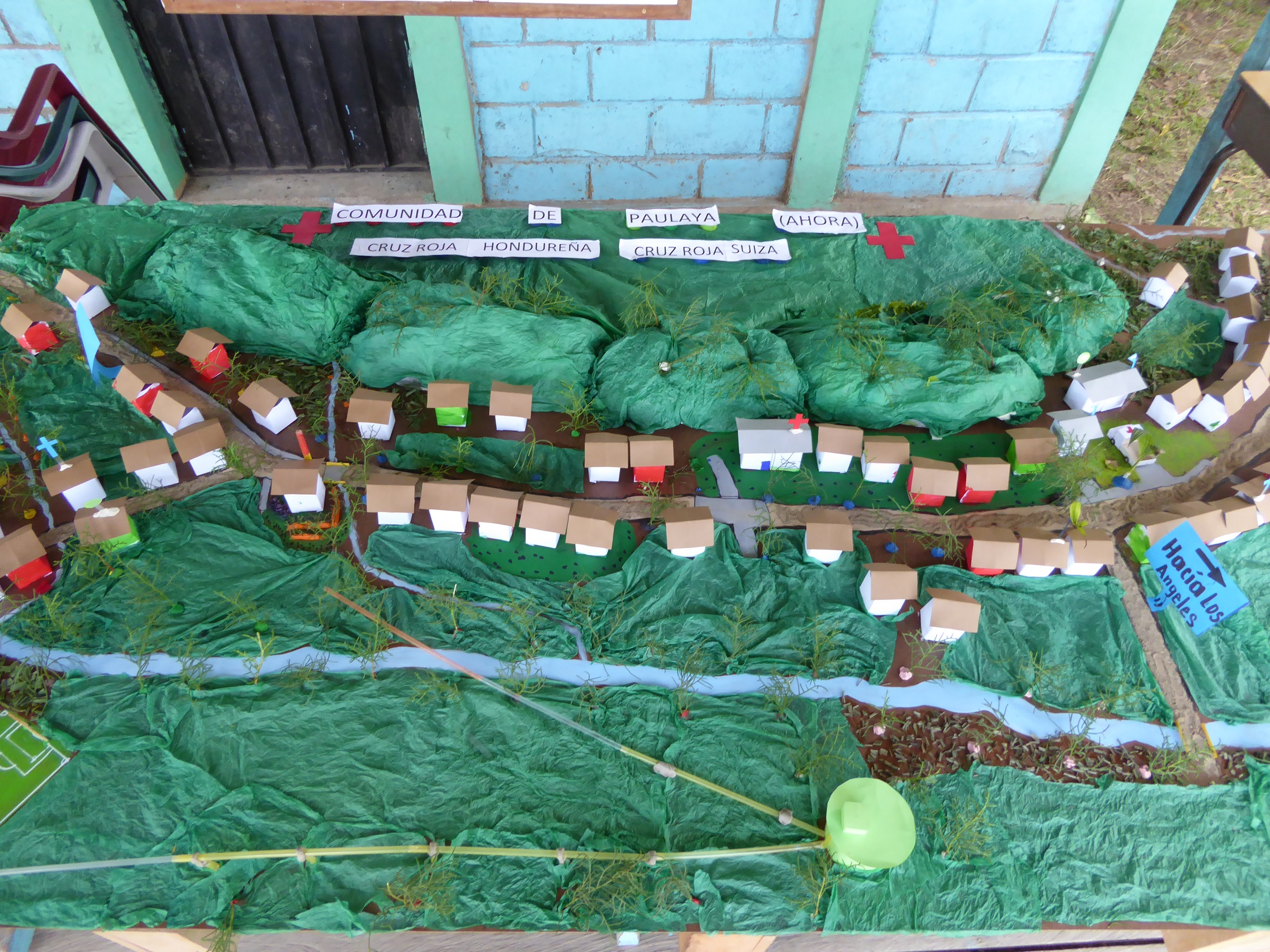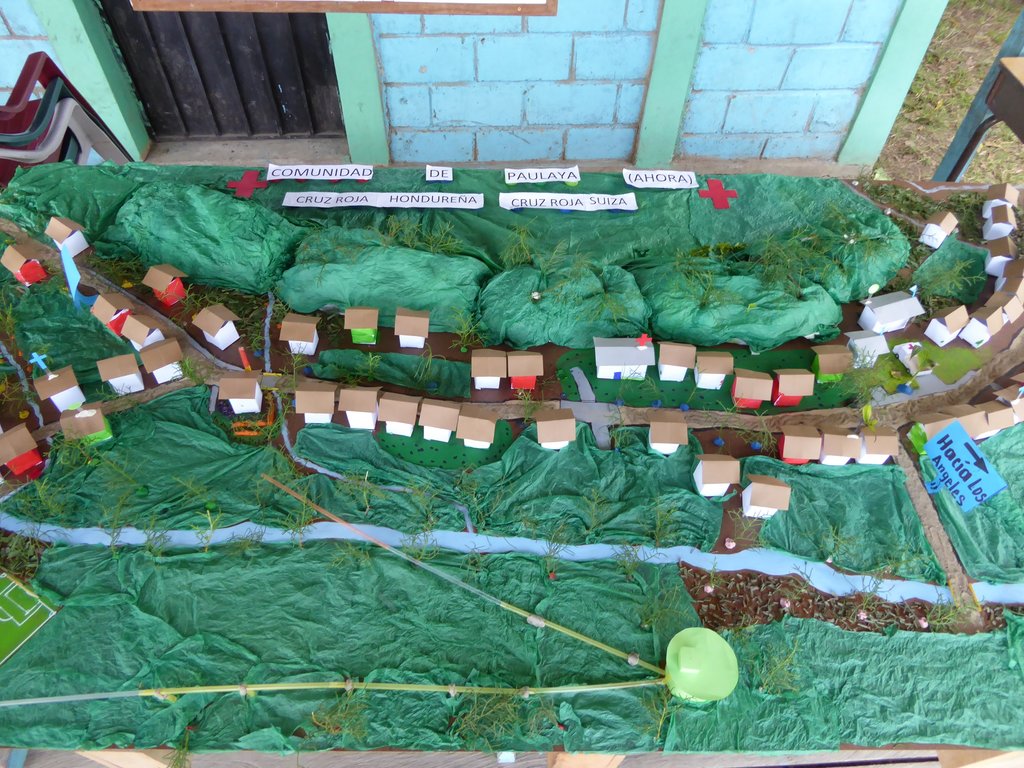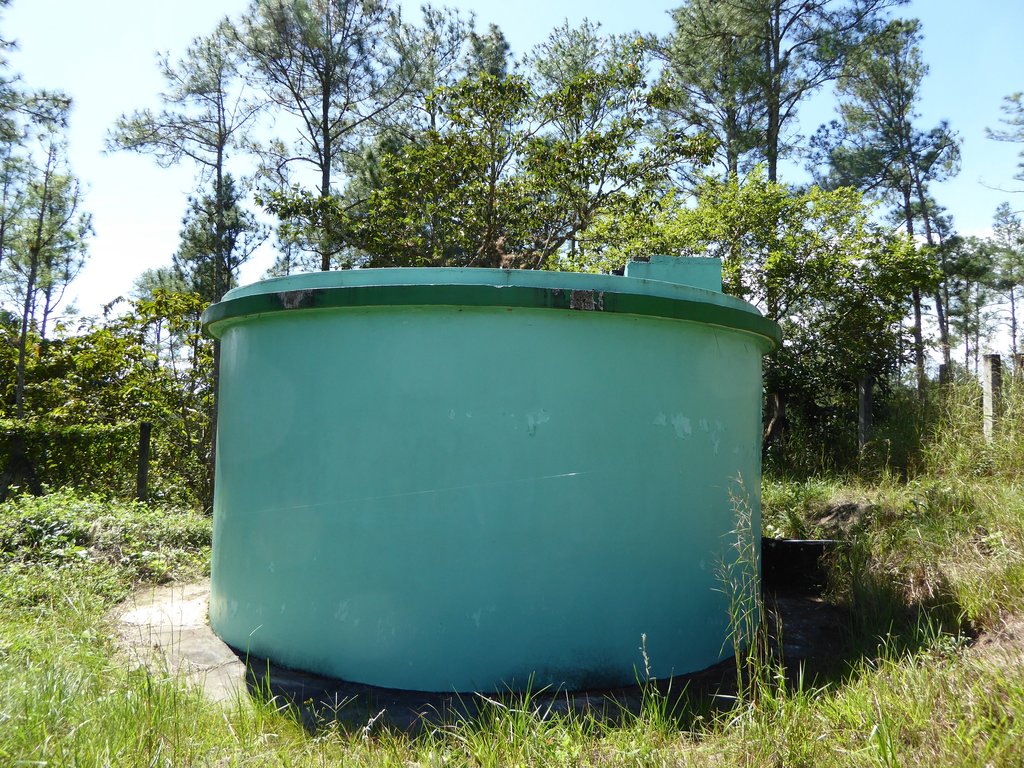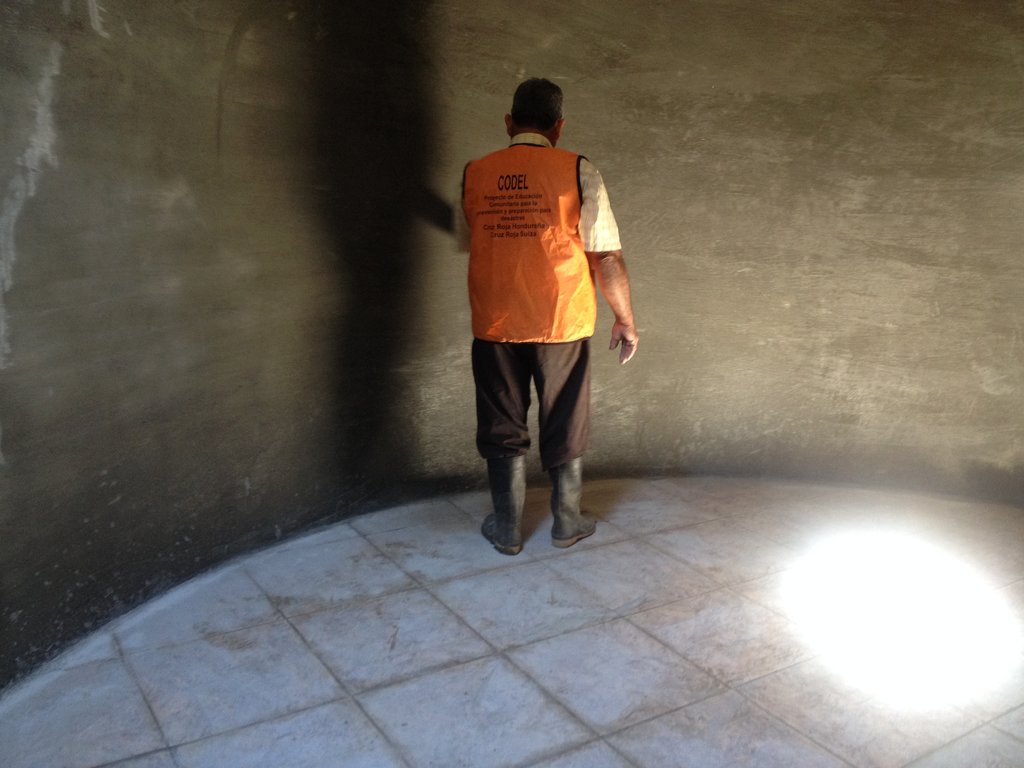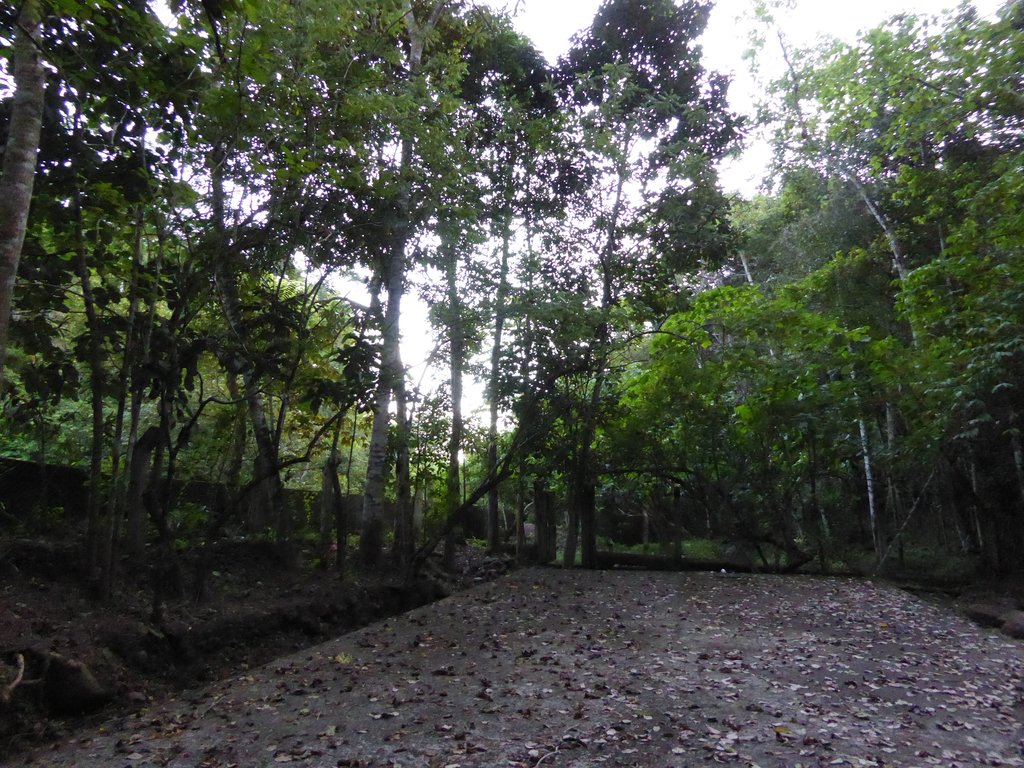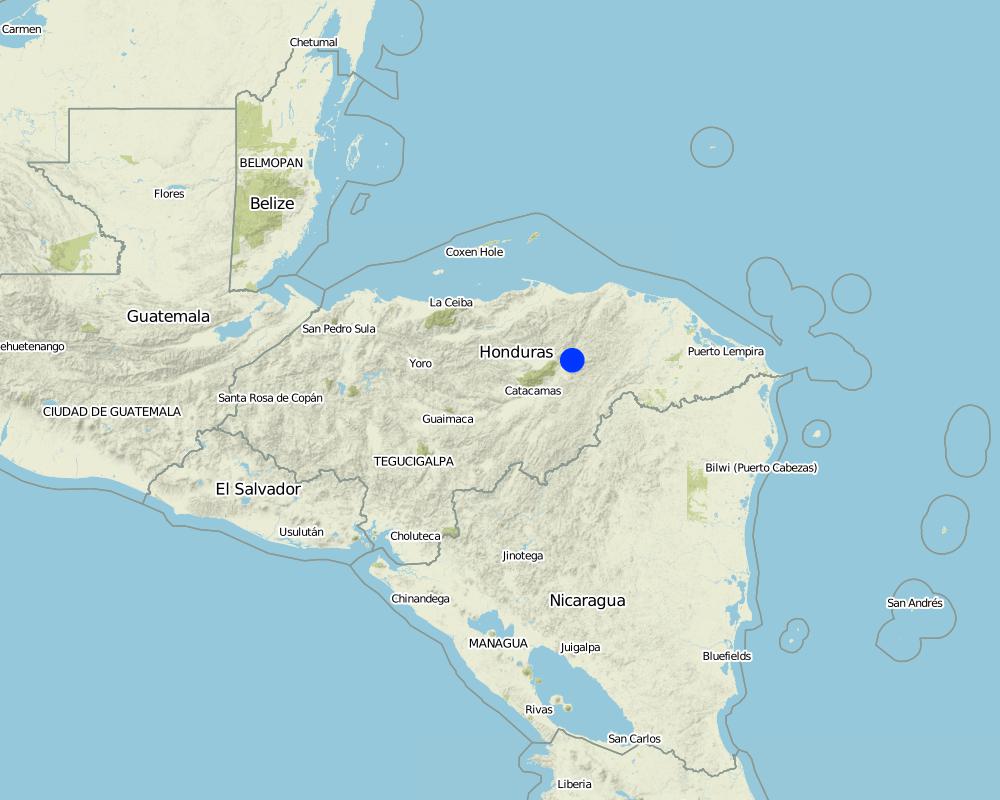Community protection of water infrastructure from hazards caused by disasters [Honduras]
- Creation:
- Update:
- Compiler: Helen Gambon
- Editor: Anton Jöhr
- Reviewers: Alexandra Gavilano, Johanna Jacobi
technologies_749 - Honduras
- Full summary as PDF
- Full summary as PDF for print
- Full summary in the browser
- Full summary (unformatted)
- Protección comunitaria de infraestructura de agua contra riesgos de desastres: March 4, 2017 (inactive)
- Community protection of water infrastructure from hazards caused by disasters : Oct. 31, 2017 (inactive)
- Community protection of water infrastructure from hazards caused by disasters : Nov. 10, 2017 (inactive)
- Community protection of water infrastructure from hazards caused by disasters: April 3, 2019 (public)
View sections
Expand all Collapse all1. General information
1.2 Contact details of resource persons and institutions involved in the assessment and documentation of the Technology
Key resource person(s)
land user:
Esenia Vanega Betty
Local Emergency Committee (in Spanish, Comité de Emergencia Local, CODEL)
Honduras
land user:
Zabala Dominguez Leonidas
Junta de Agua
Honduras
SLM specialist:
Acosta Granados Nelin Lorena
Cruz Roja Hondureña / Suiza
Honduras
1.3 Conditions regarding the use of data documented through WOCAT
The compiler and key resource person(s) accept the conditions regarding the use of data documented through WOCAT:
Yes
1.4 Declaration on sustainability of the described Technology
Is the Technology described here problematic with regard to land degradation, so that it cannot be declared a sustainable land management technology?
No
1.5 Reference to Questionnaire(s) on SLM Approaches (documented using WOCAT)
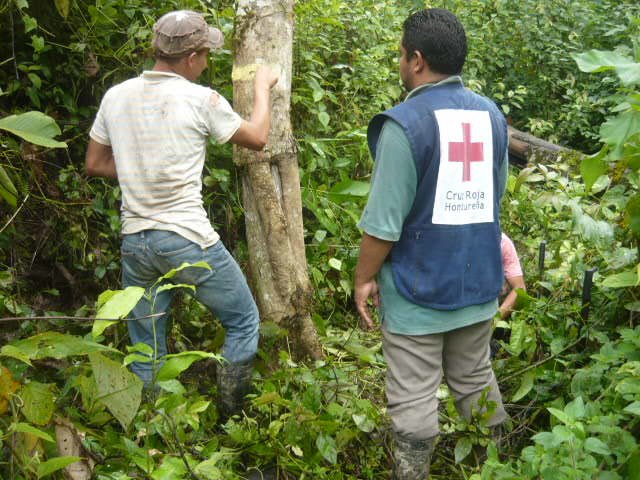
Issuing a Decree to Ensure the Legal Protection … [Honduras]
Honduran Forest Legislation establishes the strict protection of microbasins from human exploitation. However, in practice, there is an accelerated rate of microbasin degradation brought on by land use changes that turn forest lands into crop lands. Through sensitization, raising awareness, and training aimed at the general population and Water Management …
- Compiler: Helen Gambon
2. Description of the SLM Technology
2.1 Short description of the Technology
Definition of the Technology:
A series of vegetative, structural and management technologies is used reduce the exposure and vulnerability of water infrastructure to threats. These include protecting water sources and water tanks, the stabilization of their surroundings, the anchoring of piping and, whenever necessary, repairing the water tank.
2.2 Detailed description of the Technology
Description:
The Department of Olancho, located on the nortwestern region of Honduras, is frequently affected by tropical storms and hurricanes coming from the Atlantic. The Impacts of the hydrometereological hazards are intensifed by unsustainable use of natural resources practices that promote rampant forest fires, soil and water degradation and erosion. Rural communities' health is precarious.
"Resiliencia" (Resilience) is a project undertaken by the Honduran/Swiss Red Cross. It intends to provide sustainable contributions to enhance resilience in the rural regions of Olancho by combining the efforts to reduce risks posed by hazards (RHR) and those aimed at promoting health at all levels (home, community, municipality). By improving and ensuring the care of drinking water systems and providing training to manage water, wastewater and health practices, the project looks to establish for synergies between RHR and health. Though the communities already have water facilities, these are frequently old and prone to failure. The project provides communities technical and financial support to repair and improve their water system, starting from the water outlet, the water tank and the piping that extends to houses. Risk reduction is addressed throughout the entire process, Water infrastructure is protected through different measures that are defined through assessment of the state of the water system. The water tanks are improved whenever necessary, i.e. its interiors are repaired with ceramic and coating; further, the outer parts are coated and fissures are repaired. In most cases, the piping has to be changed with more resistant material (PVC is replaced with galvanized iron) to avoid fissures along the conduction line. The valves are repaired and hypochlorinators are installed. Vegetative measures - such as planting trees and shrubbery to stabilize soil and retain water - are implemented around the tanks and water outlets. These plant-based measures around the tank reduce risks of landslides; also, planting trees in the microbasin helps ensuring water provision in the quantities and quality required (for more information, see T 750). Finally, management measures are executed to reduce the risk of pollution. These measures involve, for example, ensuring strict protection of the water outlet and the water tank with a surrounding fence.
Maintenance activities include constant supervision of the pipes and cleaning of the tanks (these are emptied, cleaned with chloride and then refilled) every 8 days (in winter) and every 15 days (in the summer) by the Water Board.
2.3 Photos of the Technology
2.5 Country/ region/ locations where the Technology has been applied and which are covered by this assessment
Country:
Honduras
Region/ State/ Province:
Departament of Olancho
Further specification of location:
Dulce Nombre de Culmí municipality, Pisijire community
Specify the spread of the Technology:
- applied at specific points/ concentrated on a small area
Map
×2.6 Date of implementation
Indicate year of implementation:
2014
2.7 Introduction of the Technology
Specify how the Technology was introduced:
- through projects/ external interventions
3. Classification of the SLM Technology
3.1 Main purpose(s) of the Technology
- protect a watershed/ downstream areas – in combination with other Technologies
- reduce risk of disasters
- Improve health issues
3.2 Current land use type(s) where the Technology is applied

Settlements, infrastructure
- Water System
3.3 Has land use changed due to the implementation of the Technology?
Has land use changed due to the implementation of the Technology?
- Yes (Please fill out the questions below with regard to the land use before implementation of the Technology)
Comments:
Land Use in the microbasin area has changed from growing coffee to being protected (not used). The area surrounding the water tank has changed from being used as a grazing area to being highly guarded with a fence.
3.4 Water supply
Water supply for the land on which the Technology is applied:
- rainfed
3.5 SLM group to which the Technology belongs
- natural and semi-natural forest management
- area closure (stop use, support restoration)
3.6 SLM measures comprising the Technology

vegetative measures
- V1: Tree and shrub cover
- V2: Grasses and perennial herbaceous plants

structural measures
- S7: Water harvesting/ supply/ irrigation equipment
- S11: Others

management measures
- M1: Change of land use type
3.7 Main types of land degradation addressed by the Technology

soil erosion by water
- Wm: mass movements/ landslides

biological degradation
- Bc: reduction of vegetation cover

water degradation
- Hp: decline of surface water quality
- Hq: decline of groundwater quality
Comments:
The community's drinking water system is affected by different types of degradation. While water quality degradation is highly problematic in the microbasin, soil degradation caused by water mainly affects water infrastructure. Biological degradation affects water replenishment and quality throughout the system.
3.8 Prevention, reduction, or restoration of land degradation
Specify the goal of the Technology with regard to land degradation:
- reduce land degradation
4. Technical specifications, implementation activities, inputs, and costs
4.1 Technical drawing of the Technology
Author:
Honduran/ Swiss Red Cross
Author:
Honduran/ Swiss Red Cross
4.2 General information regarding the calculation of inputs and costs
Specify how costs and inputs were calculated:
- per Technology unit
Specify unit:
Water system coinnecting the tank to the community
other/ national currency (specify):
Lempiras
If relevant, indicate exchange rate from USD to local currency (e.g. 1 USD = 79.9 Brazilian Real): 1 USD =:
23.0
Indicate average wage cost of hired labour per day:
150 Lempiras
4.3 Establishment activities
| Activity | Timing (season) | |
|---|---|---|
| 1. | Remove the water tank's old coating | |
| 2. | Cover the floor with ceramic and coat the walls | |
| 3. | Replace PVC pipes with galvanized iron | |
| 4. | Change the water tank's valves | |
| 5. | Install a valve in the dam's desander | |
| 6. | Paint the outside of the tank | |
| 7. | Build moors to anchor pipes | |
| 8. | Planting stabilizing plants (izote) and trees | |
| 9. | Fence water tank |
Comments:
Furthermore, the microbasin is protected with reforestation measures. For more information, see "Microbasin protection through reforestation technology and the Approach "Issuing a Decree for Legal protection of microbasins".
4.4 Costs and inputs needed for establishment
| Specify input | Unit | Quantity | Costs per Unit | Total costs per input | % of costs borne by land users | |
|---|---|---|---|---|---|---|
| Labour | Trained labor | person-day | 9.0 | 750.0 | 6750.0 | |
| Labour | Untrained labor | person-day | 64.0 | 150.0 | 9600.0 | 100.0 |
| Equipment | (pick, sledgehammer, crowbar, pipe wrenches, iron cutter, wheelbarrows, etc) | set | 1.0 | 10738.0 | 10738.0 | |
| Equipment | wheelbarrow | piece | 2.0 | 19150.0 | 38300.0 | |
| Equipment | tap | |||||
| Plant material | Izote | piece | 50.0 | 7.0 | 350.0 | 100.0 |
| Construction material | Coating | day/man | 4.0 | 750.0 | 3000.0 | 100.0 |
| Construction material | Valve | piece | 1.0 | 13000.0 | 13000.0 | |
| Construction material | H.G. pipes | lance | 1.0 | 1732.0 | 1732.0 | |
| Construction material | Sand | m3 | 2.0 | 600.0 | 1200.0 | 100.0 |
| Other | Transportation of material | Trip | 3.0 | 500.0 | 1500.0 | 100.0 |
| Other | Mooring | |||||
| Total costs for establishment of the Technology | 86170.0 | |||||
| Total costs for establishment of the Technology in USD | 3746.52 | |||||
If land user bore less than 100% of costs, indicate who covered the remaining costs:
Honduran/ Swiss Red Cross
Comments:
The total cost to upgrade the water system was 92'510 Lempiras (4022 USD). 45'000 Lempiras (1957 USD) were donated by the community in the form of Labor. Honduran/ Swiss Red Cross contributed with 47'510 Lempiras (2065 USD), including trained labor 6450 Lempiras (280 USD) and construction material, gear and transportation 41'060 Lempiras (1'785 USD).
This amount does not include the wages of the technical team of Honduran/ Red Cross workers to support the community, since their field of expertise includes other activities.
4.5 Maintenance/ recurrent activities
| Activity | Timing/ frequency | |
|---|---|---|
| 1. | Dam inspection | Every 3 days |
| 2. | Pipe inspection | Continuously |
| 3. | Emptying the tank | Every 15 days; if there is heavy rain, every week |
| 4. | Rinsing walls and sweeping away sediments on the tank Joor | Every 15 days; if there is heavy rain, every week |
| 5. | Prepare a mixture of chlorine and water (tank capacity of 5000 gal: 250 ml of chlorine + 5 gallons of water; water tank capacity 10'000 gal: 500 ml of chlorine + 5 gallons of water ) | Every 15 days; if there is heavy rain, every week |
| 6. | Coat the interior of the tank with the mixture, brush, rinse with plenty of water | Every 15 days; if there is heavy rain, every week |
| 7. | Refill tank | Every 15 days; if there is heavy rain, every week |
| 8. | Charge water bill | Monthly |
4.6 Costs and inputs needed for maintenance/ recurrent activities (per year)
| Specify input | Unit | Quantity | Costs per Unit | Total costs per input | % of costs borne by land users | |
|---|---|---|---|---|---|---|
| Labour | Untrained labor | person-day | 22.0 | 150.0 | 3300.0 | 100.0 |
| Equipment | Borrow a tap | piece/day | 2.0 | 23.0 | 46.0 | 100.0 |
| Total costs for maintenance of the Technology | 3346.0 | |||||
| Total costs for maintenance of the Technology in USD | 145.48 | |||||
Comments:
The community pays for recurring maintenance costs charging for water. The training provided by the Red Cross has improved planning activities and budget investment.
4.7 Most important factors affecting the costs
Describe the most determinate factors affecting the costs:
Construction material and hardware
5. Natural and human environment
5.1 Climate
Annual rainfall
- < 250 mm
- 251-500 mm
- 501-750 mm
- 751-1,000 mm
- 1,001-1,500 mm
- 1,501-2,000 mm
- 2,001-3,000 mm
- 3,001-4,000 mm
- > 4,000 mm
Specify average annual rainfall (if known), in mm:
1400.00
Specifications/ comments on rainfall:
Dry season from January to June, rainy season from June to October, with a heat wave in August.
Agro-climatic zone
- sub-humid
5.2 Topography
Slopes on average:
- flat (0-2%)
- gentle (3-5%)
- moderate (6-10%)
- rolling (11-15%)
- hilly (16-30%)
- steep (31-60%)
- very steep (>60%)
Landforms:
- plateau/plains
- ridges
- mountain slopes
- hill slopes
- footslopes
- valley floors
Altitudinal zone:
- 0-100 m a.s.l.
- 101-500 m a.s.l.
- 501-1,000 m a.s.l.
- 1,001-1,500 m a.s.l.
- 1,501-2,000 m a.s.l.
- 2,001-2,500 m a.s.l.
- 2,501-3,000 m a.s.l.
- 3,001-4,000 m a.s.l.
- > 4,000 m a.s.l.
Indicate if the Technology is specifically applied in:
- not relevant
5.3 Soils
Soil depth on average:
- very shallow (0-20 cm)
- shallow (21-50 cm)
- moderately deep (51-80 cm)
- deep (81-120 cm)
- very deep (> 120 cm)
Soil texture (topsoil):
- coarse/ light (sandy)
Soil texture (> 20 cm below surface):
- coarse/ light (sandy)
Topsoil organic matter:
- medium (1-3%)
5.4 Water availability and quality
Ground water table:
< 5 m
Availability of surface water:
good
Water quality (untreated):
poor drinking water (treatment required)
Is water salinity a problem?
No
Is flooding of the area occurring?
Yes
Comments and further specifications on water quality and quantity:
Rain causes sporadic floods.
5.5 Biodiversity
Species diversity:
- low
Habitat diversity:
- low
5.6 Characteristics of land users applying the Technology
Sedentary or nomadic:
- Sedentary
Market orientation of production system:
- mixed (subsistence/ commercial)
Off-farm income:
- less than 10% of all income
- > 50% of all income
Relative level of wealth:
- average
Individuals or groups:
- individual/ household
- groups/ community
Level of mechanization:
- manual work
Gender:
- men
Age of land users:
- middle-aged
5.7 Average area of land used by land users applying the Technology
- < 0.5 ha
- 0.5-1 ha
- 1-2 ha
- 2-5 ha
- 5-15 ha
- 15-50 ha
- 50-100 ha
- 100-500 ha
- 500-1,000 ha
- 1,000-10,000 ha
- > 10,000 ha
Comments:
n/a (Pisijire's water system supplies water to 500 homes. The surface of land belonging to or rented by these varies consideraby and does not include in the application of the Technology).
5.8 Land ownership, land use rights, and water use rights
Land ownership:
- communal/ village
Land use rights:
- communal (organized)
Water use rights:
- communal (organized)
Comments:
The water system is organized at the community level by the Water Management Board, with the support of CODEL, particularly in issues related to protecting the water system infrastructure against hazards.
5.9 Access to services and infrastructure
health:
- poor
- moderate
- good
education:
- poor
- moderate
- good
technical assistance:
- poor
- moderate
- good
employment (e.g. off-farm):
- poor
- moderate
- good
markets:
- poor
- moderate
- good
energy:
- poor
- moderate
- good
roads and transport:
- poor
- moderate
- good
drinking water and sanitation:
- poor
- moderate
- good
financial services:
- poor
- moderate
- good
6. Impacts and concluding statements
6.1 On-site impacts the Technology has shown
Socio-economic impacts
Water availability and quality
drinking water availability
Quantity before SLM:
Quantity before SLM
Quantity after SLM:
Quantity after SLM
Comments/ specify:
There are less fissures and, thus, less water leaks, since they PVC pipes were replaced with galvanized iron.
drinking water quality
Comments/ specify:
In the case of Pisijire, water quality treatment does not take place in the water tank but in a purifying plant at the community. Thus, tap water is not apt for human consumption but rather used exclusively for washing/ cleaning/irrigation. However, the monthly water allowance (80 Lempiras = 3.5 USD) includes 90 bottles of drinking water per month per home.
Socio-cultural impacts
health situation
Quantity before SLM:
Quantity before SLM
Comments/ specify:
The improvements to the water system and the water purifier have reduced the incidence of diarrhea and other water borne diseases.
land use/ water rights
Quantity before SLM:
Quantity before SLM
Comments/ specify:
Water access has not changed due to technology; rights of use are determined by paying the monthly bill.
community institutions
Comments/ specify:
The Water Board as well as the Local Emergency Committee (CODEL, Spanish acronym) have been improved through comprehensive management of the water system, for example, taking into account the water cycles, maintenance of the infrastructure, fund distribution and management.
SLM/ land degradation knowledge
Quantity before SLM:
Quantity before SLM
Comments/ specify:
The Water Board and the Local Emergency Committee (CODEL, Acronym in Spanish for Comité de Emergencia Local) are aware of the importance of protecting the water source through soil conservation.
6.2 Off-site impacts the Technology has shown
water availability
Specify assessment of off-site impacts (measurements):
n/a
6.3 Exposure and sensitivity of the Technology to gradual climate change and climate-related extremes/ disasters (as perceived by land users)
Gradual climate change
Gradual climate change
| Season | increase or decrease | How does the Technology cope with it? | |
|---|---|---|---|
| annual temperature | increase | well | |
| seasonal temperature | summer | increase | not known |
| seasonal rainfall | summer | decrease | well |
Climate-related extremes (disasters)
Meteorological disasters
| How does the Technology cope with it? | |
|---|---|
| tropical storm | moderately |
Climatological disasters
| How does the Technology cope with it? | |
|---|---|
| drought | well |
| forest fire | moderately |
Hydrological disasters
| How does the Technology cope with it? | |
|---|---|
| general (river) flood | very well |
| landslide | well |
6.4 Cost-benefit analysis
How do the benefits compare with the establishment costs (from land users’ perspective)?
Short-term returns:
positive
Long-term returns:
positive
How do the benefits compare with the maintenance/ recurrent costs (from land users' perspective)?
Short-term returns:
very positive
Long-term returns:
slightly positive
Comments:
In the future, one water tank will not be enough for the community, since it is growing rapidly. An investment in piping will also be needed.
6.5 Adoption of the Technology
- > 50%
If available, quantify (no. of households and/ or area covered):
500 homes (100% of the community) have access to drinking water
Of all those who have adopted the Technology, how many did so spontaneously, i.e. without receiving any material incentives/ payments?
- 0-10%
6.6 Adaptation
Has the Technology been modified recently to adapt to changing conditions?
No
6.7 Strengths/ advantages/ opportunities of the Technology
| Strengths/ advantages/ opportunities in the land user’s view |
|---|
| Protection of the microbasin ensurea water quantity and quality. |
| Water is a necessary resource and it motivates people to invest their effort into protecting and maintaining the system. Also, it is easy to fine people who break regulations to ensure the lands belonging to the microbasin are not used, this can deplete water. |
| Availability of drinking water improves the health of the population. This increases labor and in the long run it will result in development for the community. |
| Strengths/ advantages/ opportunities in the compiler’s or other key resource person’s view |
|---|
| Improves the comprehensive management of water system and thus improves coordination efforts with CODEL, the Health Committee and the investment plan. |
6.8 Weaknesses/ disadvantages/ risks of the Technology and ways of overcoming them
| Weaknesses/ disadvantages/ risks in the land user’s view | How can they be overcome? |
|---|---|
| In the future, the water tank will no longer cover the needs of their growing population |
Expand pipe network build a second tank (opinion of the Board and CODEL) Set a quota according to water use to avoid waste (opinion of the compiler) |
7. References and links
7.1 Methods/ sources of information
- field visits, field surveys
1
- interviews with land users
2
- interviews with SLM specialists/ experts
1
When were the data compiled (in the field)?
22/11/2016
Links and modules
Expand all Collapse allLinks

Issuing a Decree to Ensure the Legal Protection … [Honduras]
Honduran Forest Legislation establishes the strict protection of microbasins from human exploitation. However, in practice, there is an accelerated rate of microbasin degradation brought on by land use changes that turn forest lands into crop lands. Through sensitization, raising awareness, and training aimed at the general population and Water Management …
- Compiler: Helen Gambon
Modules
No modules


